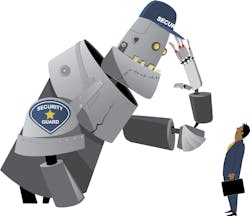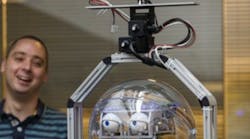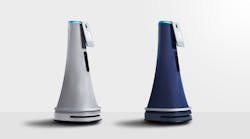Advanced Robotics and AI are Revolutionizing Guard Force Management
Security operations are undergoing a significant transformation. As enterprise organizations face escalating security threats, increasing operational costs, and evolving compliance requirements, traditional guard force models struggle to keep pace. Advanced robotics and artificial intelligence (AI) are emerging as game-changing technologies, enabling security teams to enhance operational efficiency, strengthen perimeter protection, and mitigate risks across diverse environments. From corporate campuses and healthcare facilities to critical infrastructure sites, AI-powered solutions are redefining the role of security personnel while improving overall effectiveness.
The Challenges Facing Traditional Guard Force Management
Security teams are expected to provide comprehensive protection against an evolving landscape of threats. However, they often encounter several limitations:
- High Labor Costs: Security personnel costs continue to rise, making 24/7 coverage expensive.
- Human Limitations: Guards can only be in one place at a time and may experience fatigue, distraction, or inconsistencies in monitoring and response.
- Reactive Approach: Traditional security systems often rely on surveillance footage for post-incident investigations rather than real-time deterrence and intervention.
- Coverage Gaps: Large, multi-facility organizations struggle to maintain full visibility across extensive perimeters and access points.
These challenges necessitate a shift toward smarter, more efficient security solutions that augment human capabilities rather than replace them.
The Industry’s Shift Toward Automation: Lessons from Other Sectors
The transition from human-reliant labor to automation is not unique to the security industry. Across multiple sectors, technology has gradually taken over roles that were once exclusively performed by people, often increasing efficiency, reducing costs, and enhancing overall reliability. Manufacturing, for example, has undergone a massive transformation with the introduction of robotics and automated assembly lines. What was once an industry requiring thousands of hands-on workers now operates with minimal human intervention, using robotic arms and AI-driven logistics to optimize production. Similarly, the automotive industry has seen a drastic reduction in human-operated processes, with self-driving transport systems and automated quality control ensuring precision and efficiency at a previously unimaginable scale.
The retail and hospitality sectors have also experienced a surge in automation. Cashiers, once the backbone of retail checkout operations, are increasingly being replaced by self-checkout kiosks and AI-powered inventory management systems. Fast-food chains have begun integrating automated food preparation stations and digital ordering systems, reducing reliance on manual labor while improving service speed and consistency. Even transportation and logistics, long dependent on human drivers and warehouse workers, have been reshaped by AI and robotics, with autonomous delivery vehicles and automated sorting facilities streamlining operations. The security industry is following a similar trajectory. AI-driven surveillance, robotic patrols, and Large Language Model (LLM)-powered communication agents take over repetitive, labor-intensive tasks, allowing human personnel to focus on higher-level oversight and response coordination.
The Role of Robotics and AI in Modern Security Operations
AI-driven security technology and autonomous robotic systems transform organizations' guard force management. By integrating intelligent automation, companies can create a hybrid security model that optimizes human resources while leveraging advanced analytics, machine learning, and autonomous surveillance.
Key advantages of AI and robotics in security operations include:
- Real-Time Data Analysis: AI systems can process vast amounts of surveillance data in real-time, detecting anomalies, identifying potential threats, and instantly alerting security teams or law enforcement.
- Autonomous Surveillance & Patrols: Robotic security units can continuously patrol facilities, monitor unauthorized access, and provide situational awareness without requiring direct human oversight.
- Incident Response and Communication: AI-powered systems can engage intruders through voice alerts, notify security personnel of potential threats, and even integrate with law enforcement dispatch centers.
- Predictive Threat Detection: AI algorithms analyze patterns to identify potential security risks before they escalate.
- Scalability: AI-based security solutions are adaptable to different industries, providing seamless protection across multiple sites without requiring extensive personnel increases.
AI-Driven Communication and Autonomous Intelligent Response
Beyond physical security, the effectiveness of an automated security strategy depends on its ability to communicate threats and coordinate responses in real-time. AI-powered communication systems, such as LLM-powered, cloud-based AI agents, are revolutionizing security operations by providing automated, context-aware response capabilities.
AI-driven security technology and autonomous robotic systems transform organizations' guard force management.
The Role of LLM-Powered AI Agents in Security
These advanced AI agents leverage natural language processing and real-time data analysis to autonomously assess situations, engage with individuals, and provide actionable intelligence. Unlike traditional automated systems, LLM-powered agents can understand and respond to dynamic security scenarios, making them a critical tool for modern security teams.
- Real-Time Threat Assessment: AI agents can evaluate live security feeds, access control logs, and environmental data to determine potential threats.
- Context-Aware Responses: AI agents can differentiate between routine activities and suspicious behavior using AI and historical data, ensuring accurate threat prioritization.
- Autonomous Engagement: These agents can issue voice alerts, request identification, and provide instructions to individuals in restricted areas, reducing the burden on human security personnel.
Enhancing Security Coordination with AI Agents
By integrating with broader security ecosystems, LLM-powered AI agents facilitate seamless communication between surveillance devices, access control systems, and security personnel. Key benefits include:
- Automated Escalation Protocols: When a high-risk situation is detected, AI agents can instantly escalate alerts to on-site personnel or law enforcement, ensuring rapid response.
- Incident Documentation and Analysis: AI-driven platforms compile security data, enabling organizations to review past incidents, identify trends, and refine security protocols.
- Multi-Layered Security Integration: AI agents work alongside stationary, portable, and mobile security solutions, creating a cohesive security network capable of surveillance and response.
By implementing AI-driven communication systems, organizations can ensure that their security framework is proactive and capable of real-time engagement and dynamic response management.
Diverse Automation Solutions: Stationary, Portable, and Mobile Robotics
Security automation is not a one-size-fits-all approach. Different environments require different solutions, and the security industry has responded by developing three primary categories of robotic and AI-driven security technologies: stationary, portable, and mobile solutions. Each type offers unique advantages based on an organization's security needs.
Stationary Security Solutions
Stationary AI-powered security devices are designed to monitor fixed locations such as entry points, high-traffic areas, and critical infrastructure zones. These solutions often include:
- AI-enhanced surveillance cameras: Capable of perimeter breach detections, after-hour trespassing detection and deterrence, and real-time alarms and alerting.
- Automated access control systems: Managing entry permissions and verifying credentials with AI-driven validation.
- Remote monitoring hubs: Providing a centralized security overview with AI-driven data aggregation and analytics.
Portable Security Solutions
Portable security devices provide flexibility, allowing security teams to deploy advanced monitoring and deterrent systems as needed. These solutions are beneficial for:
- Construction sites: Preventing unauthorized access and deterring theft of valuable equipment.
- Event security: Enhancing perimeter control and crowd monitoring.
- Temporary high-risk areas: Quickly addressing security vulnerabilities without requiring permanent installations.
Mobile Robotic Security Solutions
Mobile robotic security solutions are redefining surveillance patrol operations. These autonomous units can navigate facilities, parking lots, and outdoor environments while continuously analyzing surroundings for security threats. Key use cases include:
- Corporate campuses: Providing proactive security coverage while reducing reliance on human patrols.
- Logistics hubs and warehouses: Protecting against theft, ensuring access control, and reducing internal security risks.
- Healthcare facilities: Enhancing staff safety and securing restricted areas with AI-driven patrols.
By integrating a combination of stationary, portable, and mobile security technologies, organizations can establish a comprehensive security strategy tailored to their unique requirements.
The Time for Security Automation is Now
For years, businesses hesitated to embrace automation in security due to concerns over reliability, adaptability, and integration with existing infrastructure. While promising, early AI-powered systems and robotic security units often faced challenges in real-world deployments. However, technology has now advanced to the point where these concerns have been addressed and resolved. AI-driven security solutions are no longer experimental; they are operational and tested and deliver measurable results across various industries. Advances in autonomous intelligent response capabilities and real-time data processing have made AI security systems more effective than ever. Organizations now have access to security automation that is reliable, scalable, and capable of reducing risk while optimizing operational costs.
While promising, early AI-powered systems and robotic security units often faced challenges in real-world deployments. However, technology has now advanced to the point where these concerns have been addressed and resolved.
In addition to technological advancements, shifting workforce dynamics and economic pressures have made security automation a practical necessity rather than an option for the future. Rising labor costs, high employee turnover, and a shortage of trained security professionals have made it difficult for organizations to maintain adequate coverage. AI-powered surveillance, robotic patrols, and autonomous intelligent response systems provide a solution by filling coverage gaps, reducing reliance on human personnel for routine tasks, and ensuring that security operations remain uninterrupted. With successful deployments in corporate campuses, healthcare facilities, logistics hubs, and retail environments, security automation is no longer a concept that organizations should evaluate cautiously. Its proven strategy enables businesses to enhance protection, improve efficiency, and achieve a more substantial return on investment.
Training and Customizing AI-Driven Security Solutions
Automation is often not a plug-and-play solution; it requires thoughtful implementation, continuous training, and refinement to align with an organization’s security protocols. AI-powered surveillance systems must be trained to recognize threats accurately, distinguish between routine activities and suspicious behavior, and respond appropriately to different scenarios. This process mirrors how businesses optimize AI assistants by refining prompts, defining workflows, and setting clear objectives. Just as an AI language model can be tuned to deliver industry-specific insights, security automation solutions must be configured to detect unique risks and function seamlessly within a given environment.
Customization extends beyond training AI models. Security teams must establish rules of engagement for autonomous intelligent response agents, ensuring that automated systems act in a way that aligns with an organization’s safety policies. Whether it’s setting response thresholds, defining alert escalation protocols, or programming AI-driven communication agents to interact with individuals in a specific manner, the success of automation depends on how well it is tailored to operational needs. Organizations that treat automation as an evolving, adaptive solution rather than a static replacement for human personnel will achieve the best results, unlocking efficiencies while maintaining control over their security environment.
While AI and robotics are transforming security operations, the role of human security professionals remains critical. The best security personnel are not being replaced; they are evolving into higher-value roles focusing on managing, deploying, and optimizing these advanced technologies. Just as cybersecurity professionals configure and oversee digital security systems, physical security experts are now responsible for training AI-driven solutions, fine-tuning autonomous patrols, and ensuring that robotic systems align with real-world security needs. Those with deep industry knowledge and expertise in situational assessment will lead to the integration of automation, ensuring that AI enhances rather than diminishes the effectiveness of security programs. The future of security belongs to automation and those who understand how to harness it strategically.
The Future of Security Operations
Adopting AI and robotics in security is not futuristic; it is happening now. Organizations that embrace these technologies will gain a competitive advantage by improving security effectiveness, optimizing costs, and enhancing operational resilience. The future of guard force management lies in the seamless integration of human expertise with AI-driven automation, creating a proactive, adaptable, and intelligent security strategy.
Security professionals who understand and embrace these technologies will play a key role in shaping the industry's future, ensuring that businesses, institutions, and critical infrastructure remain safe in an increasingly complex security environment.
AI in GSOC Operations
By Ryan Schonfeld, Co-Founder & CEO, HiveWatch
The security industry has been at a turning point in the last few years. The term “artificial intelligence” (AI) is thrown around a lot – dangerously close to becoming the dreaded “analytics” from years past. Not specific to security, boards are instilling a mandate to “invest in AI” without really understanding its role in the broader business scope and finding operational efficiencies and cost savings. And security is not immune.
But here's the revolution hiding in plain sight: AI isn't just another board mandate. It's the answer to security's most crippling problems. Inside a Global Security Operations Center (GSOC), AI is poised to make a massive impact, taking automation to a whole new level to streamline operations.
It’s well known that security teams today are drowning in video feeds and alarms while struggling with staff turnover and missing incidents. They’re inundated with repetitive and mundane tasks, tying them down with low-impact, time-consuming work. This type of activity creates intense frustration, leading to complacency, burnout, and high turnover, and is ultimately a waste of company funds and resources.
As physical security grows and transforms into the new age of rapidly advancing AI and technology, the industry must embrace this new era to improve the critical work the people in physical security are doing. By removing monotonous and laborious tasks, personnel can be upskilled and enabled to do more impactful, meaningful, and proactive work. Being pragmatic, the rest of the enterprise is starting to leverage AI; don’t get left behind.
This potentially looks like an AI Operator handling routine surveillance and dispatch – ingesting incoming alerts and alarms and being explicitly trained to customize standard operating procedures (SOPs) to resolve the incident or elevate it to a human operator for further assessment and response. This allows security professionals to focus on what humans do best – strategic thinking, emergency response, and complex decision-making. Let them do that. Let AI handle the rest – the routine surveillance, the basic dispatch, the endless alert monitoring. It's not necessarily about replacing humans; it's about unleashing them.
AI can shift the conversation with the C-suite from “doing more with less” to “let’s figure out how to elevate the entire business with this technology.”
It's time to stop talking about AI and start wielding it – turning security teams into strategic assets that deliver real ROI. The future isn't about throwing more bodies at the problem. It's about smart automation that scales operations without breaking budgets. It's about elevating your security operation from necessary evil to business driver.
AI in security isn't a buzzword anymore. It's a force multiplier that's already transforming the industry. The question isn't whether to embrace it – how fast you can get on board.
About the Author

Steve Reinharz
Founder and CEO, Robotic Assistance Devices
Steve Reinharz is the CEO and CTO of Robotic Assistance Devices, which he founded in 2016. He spearheads AI-powered solutions tailored for the guarding and facility management industries. With over 25 years of experience in the physical security industry, Steve has driven RAD’s deployment of nearly 1,000 AI-driven products worldwide.
At the age of 24, Steve founded one of California’s leading security integration companies, which he later sold for $42 million. He is an active Board member of the Security Industry Association (SIA) and currently chairs the ‘AI, Drones, and Robotics Interest Group.’ A frequent speaker at major industry events, Steve’s innovations, including RAD Light My Way and RAD’s Firearm Detection application, transform security and facility management globally.

Mark Folmer
VP, Security Industry, TrackTik Software
With 28 years of experience in the security industry, Mark Folmer is the President of Robotic Assistance Devices. Known for driving growth, innovation, and operational excellence, Mark builds high-performing, customer-centric teams and delivers advanced security solutions to SMEs and Fortune 500 companies.
A two-time IFSEC Global Influencer in Security Thought Leadership, Mark is recognized for bridging business goals with security programs and shaping the industry's future. He frequently speaks at major security conferences and contributes to organizations like ASIS International and IFSEC Global. Mark also serves as the North American Regional Board of Directors Chairperson for ASIS International.



